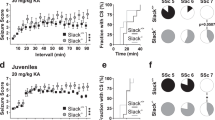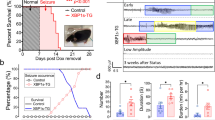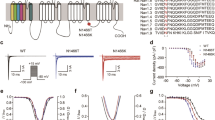Abstract
Febrile seizures are the most common type of developmental seizures, affecting up to 5% of children. Experimental complex febrile seizures involving the immature rat hippocampus led to a persistent lowering of seizure threshold despite an upregulation of inhibition. Here we provide a mechanistic resolution to this paradox by showing that, in the hippocampus of rats that had febrile seizures, the long-lasting enhancement of the widely expressed intrinsic membrane conductance Ih converts the potentiated synaptic inhibition to hyperexcitability in a frequency-dependent manner. The altered gain of this molecular inhibition–excitation converter reveals a new mechanism for controlling the balance of excitation–inhibition in the limbic system. In addition, here we show for the first time that h-channels are modified in a human neurological disease paradigm.
This is a preview of subscription content, access via your institution
Access options
Subscription info for Japanese customers
We have a dedicated website for our Japanese customers. Please go to natureasia.com to subscribe to this journal.
Buy this article
- Purchase on SpringerLink
- Instant access to full article PDF
Prices may be subject to local taxes which are calculated during checkout





Similar content being viewed by others
References
Otis, T.S., De Koninck, Y. & Mody, I. Lasting potentiation of inhibition is associated with an increased number of gamma-aminobutyric acid type A receptors activated during miniature inhibitory postsynaptic currents. Proc. Natl. Acad. Sci. USA 91, 7698–702 (1994).
Nusser, Z., Hájos, N., Somogyi, P. & Mody, I. Increased number of synaptic GABA(A) receptors underlies potentiation at hippocampal inhibitory synapses. Nature 395, 172–177 (1998).
Brooks-Kayal, A.R., Shumate, M.D., Jin, H., Rikhter, T.Y. & Coulter, D.A. Selective changes in single cell GABAA receptor subunit expression and function in temporal lobe epilepsy. Nature Med. 4, 1166–1172 (1998).
Buhl, E.H., Otis, T.S. & Mody, I. Zinc-induced collapse of augmented inhibition by GABA in a temporal lobe epilepsy model. Science 271, 369–373 (1996).
Chen, K., Baram, T.Z. & Soltesz, I. Febrile seizures in the developing brain result in persistent modification of neuronal excitability in limbic circuits. Nature Med. 5, 888–894 (1999).
Walker, M.C. & Kullmann, D.M. Febrile convulsions: a 'benign' condition? Nature Med. 5, 871–872 (1999).
Shinnar, S. Prolonged febrile seizures and mesial temporal sclerosis. Ann. Neurol. 43, 411–412 (1998).
Cendes, F. et al. Early childhood prolonged febrile convulsions, atrophy and sclerosis of mesial structures, and temporal lobe epilepsy: an MRI volumetric study. Neurology 43, 1083–1087 (1993).
Dube, C. et al. Prolonged febrile seizures in the immature rat model enhance hippocampal excitability long term. Ann. Neurol. 47, 336–344 (2000).
Baram, T.Z., Gerth, A. & Schultz, L. Febrile seizures: an appropriate-aged model suitable for long-term studies. Dev. Brain Res. 98, 265–270 (1997).
VanLandingham, K.E., Heinz, E.R., Cavazos, J.E. & Lewis, D.V. Magnetic resonance imaging evidence of hippocampal injury after prolonged focal febrile convulsions. Ann. Neurol. 43, 413–426 (1998).
Brown, H.F., DiFrancesco, D. & Noble, S.J. How does adrenaline accelerate the heart? Nature 280, 235–236 (1979).
Mayer, M.L. & Westbrook, G.L. A voltage-clamp analysis of inward (anomalous) rectification in mouse spinal sensory ganglion neurones. J. Physiol. (Lond.) 340, 19–45 (1983).
Pape, H.C. & McCormick, D.A. Noradrenaline and serotonin selectively modulate thalamic burst firing by enhancing a hyperpolarization-activated cation current. Nature 340, 715–718 (1989).
Soltesz, I. et al. Two inward currents and the transformation of low-frequency oscillations of thalamocortical cells. J. Physiol. (Lond.) 441, 175–197 (1991).
Maccaferri, G. & McBain, C.J. The hyperpolarization-activated current (Ih) and its contribution to pacemaker activity in rat CA1 hippocampal stratum oriens-alveus interneurones. J. Physiol. (Lond.) 497, 119–130 (1996).
Pape, H.C. Queer current and pacemaker: the hyperpolarization-activated cation current in neurons. Ann. Rev. Physiol. 58, 299–327 (1996).
Santoro, B. & Tibbs, G.R. The HCN gene family: molecular basis of the hyperpolarization-activated pacemaker channels. Ann. NY Acad. Sci. 868, 741–764 (1999).
Beaumont, V. & Zucker, R.S. Enhancement of synaptic transmission by cyclic AMP modulation of presynaptic Ih channels. Nature Neurosci. 3, 133–141 (2000).
Siegelbaum, S.A. Presynaptic facilitation by hyperpolarization-activated pacemaker channels. Nature Neurosci. 3, 101–102 (2000).
BoSmith, R.E., Briggs, I. & Sturgess, N.C. Inhibitory actions of ZENECA ZD7288 on whole-cell hyperpolarization activated inward current (If) in guinea-pig dissociated sinoatrial node cells. Brit. J. Pharm. 110, 343–349 (1993).
Soltesz, I. & Deschênes, M. Low- and high-frequency membrane-potential oscillations during theta activity in morphologically identified neurons of the rat hippocampus during ketamine-xylazine anesthesia. J. Neurophysiol. 70, 97–116 (1993).
Harris, N.C & Constanti, A. Mechanism of block by ZD-7288 of the hyperpolarization-activated inward rectifying current in guinea pig substantia nigra neurons in vitro. J. Neurophysiol. 74, 2366–2378 (1995).
Staley, K.J., Soldo, B.L. & Proctor, W.R. Ionic mechanisms of neuronal excitation by inhibitory GABAA receptors. Science 269, 977–981 (1995).
Storm, J.F. Temporal integration by a slowly inactivating K+ current in hippocampal neurons. Nature 336, 379–381 (1988).
Krause, M. & Pedarzani, P. A protein phosphatase is involved in the cholinergic suppression of the Ca2+-activated K+ current sIAHP in hippocampal pyramidal neurons. Neuropharmacology 39, 1274–1283 (2000).
Hines, M.L. Computer modeling methods for neurons. in The Handbook of Brain Theory and Neural Networks. (ed. Arbib, M.A.) 226–230 (MIT Press, Cambridge, Massachusetts, 1995).
Aradi, I. & Holmes, W.R. Role of multiple calcium and calcium-dependent conductances in regulation of hippocampal dentate granule cell excitability. J. Comput. Neurosci. 6, 215–235 (1999).
Freund, T.F. & Buzsáki, G. Interneurons of the hippocampus. Hippocampus 6, 347–470 (1996).
Magee, J.C. Dendritic hyperpolarization-activated currents modify the integrative properties of hippocampal CA1 pyramidal neurons. J. Neurosci. 18, 7613–7624 (1998).
Holmes, G.L. & Ben-Ari, Y. Seizures in the developing brain: Perhaps not so benign after all. Neuron 21, 1231–1234 (1998).
Villeneuve, N., Ben-Ari, Y., Holmes, G.L. & Gaiarsa, J.-L. Neonatal seizures induced persistent changes in intrinsic properties of CA1 rat hippocampal cells. Ann. Neurol. 47, 729–738 (2000).
Santoro, B., Grant, S.G., Bartsch, D. & Kandel, E.R. Interactive cloning with the SH3 domain of N-src identifies a new brain specific ion channel protein, with homology to eag and cyclic nucleotide-gated channels. Proc. Natl. Acad. Sci. USA 94, 14815–14820 (1997).
Santoro, B. et al. Identification of a gene encoding a hyperpolarization-activated pacemaker channel of brain. Cell 93, 717–729 (1998).
Ludwig, A., Zong, X., Jeglitsch, M., Hofmann, F. & Biel, M. A family of hyperpolarization-activated mammalian cation channels. Nature 393, 587–591 (1998).
Moosmang, S., Biel, M., Hofmann, F. & Ludwig, A. Differential distribution of four hyperpolarization-activated cation channels in mouse brain. Biol. Chem . 380, 975–980 (1999).
Maccaferri, G., Mangoni, M., Lazzari, A. & DiFrancesco, D. Properties of the hyperpolarization-activated current in rat hippocampal CA1 pyramidal cells. J. Neurophysiol. 69, 2129–2136 (1993).
Lüthi, A. & McCormick, D.A. Modulation of a pacemaker current through Ca2+-induced stimulation of cAMP production. Nature Neurosci. 2, 634–41 (1999).
DiFrancesco, D. & Tortora, P. Direct activation of cardiac pacemaker channels by intracellular cyclic AMP. Nature 351, 145–7 (1991).
Baker, K., Warren, K.S. Yellen, G., & Fishman, M.C. Defective “pacemaker” current (Ih) in a zebrafish mutant with a slow heart rate. Proc. Natl. Acad. Sci. USA 94, 4554–4559 (1997).
Smith, R.L., Clayton, G.H., Wilcox, C.L., Escudero, K.W. & Staley, K.J. Differential expression of an inwardly rectifying chloride conductance in rat brain neurons: A potential mechanism for cell-specific modulation of inhibition. J. Neurosci. 15, 4057–4067 (1995).
Hollrigel, G.H., Toth, K. & Soltesz, I. Neuroprotection by propofol in acute mechanical injury: Role of GABAergic inhibition. J. Neurophysiol. 76, 2412–2422 (1996).
Spruston, N. & Johnston, D. Perforated patch-clamp analysis of the passive membrane properties of three classes of hippocampal neurons. J. Neurophysiol. 67, 508–529 (1992).
Numann, R.E., Wadman, W.J. & Wong, R.K. Outward currents of single hippocampal cells obtained from the adult guinea-pig. J. Physiol. (Lond.) 393, 331–353 (1987).
Magee, J.C. & Johnston, D. Characterization of single voltage-gated Na+ and Ca2+ channels in apical dendrites of rat CA1 pyramidal neurons. J. Physiol. (Lond.) 487, 67–90 (1995).
Acknowledgements
We thank R. Zhu for technical assistance. This work was financially supported by the NIH (NS38580 to I.S. and NS35439 to T.Z.B.), by the UC Systemwide Biotechnology Research and Education Program (BREP-98-02 to T.Z.B. & I.S.) and by a Postdoctoral Fellowship from the Epilepsy Foundation of America (to I.A.).
Author information
Authors and Affiliations
Corresponding author
Rights and permissions
About this article
Cite this article
Chen, K., Aradi, I., Thon, N. et al. Persistently modified h-channels after complex febrile seizures convert the seizure-induced enhancement of inhibition to hyperexcitability. Nat Med 7, 331–337 (2001). https://doi.org/10.1038/85480
Received:
Accepted:
Issue Date:
DOI: https://doi.org/10.1038/85480
This article is cited by
-
Investigation of hyperpolarization-activated cyclic nucleotide-gated (HCN) channels in vitro inflammation model at molecular level
Molecular and Cellular Biochemistry (2023)
-
Discrete subicular circuits control generalization of hippocampal seizures
Nature Communications (2022)
-
Neurostimulation stabilizes spiking neural networks by disrupting seizure-like oscillatory transitions
Scientific Reports (2020)
-
Differential roles of NaV1.2 and NaV1.6 in regulating neuronal excitability at febrile temperature and distinct contributions to febrile seizures
Scientific Reports (2018)
-
Age-Related ECoG Dynamics of and Convulsive Activity of Wistar Rats in a Cortical Model of Focal Epilepsy
Neuroscience and Behavioral Physiology (2018)



